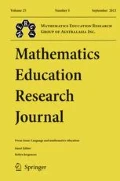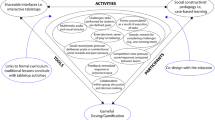Abstract
The aim of this paper is to reflect on the importance of the students’ game-strategic thinking during the development of mathematical activities. In particular, we hypothesise that this type of thinking helps students in the construction of logical links between concepts during the “argumentation phase” of the proving process. The theoretical background of our study lies in the works of J. Hintikka, a Finnish logician, who developed a new type of logic, based on game theory, called the logic of inquiry. In order to experiment with this new approach to the teaching and learning of mathematics, we have prepared five game-activities based on geometric theorems in which two players play against each other in a multi-touch dynamic geometric environment (DGE). In this paper, we present the design of the first game-activity and the relationship between it and the logic of inquiry. Then, adopting the theoretical framework of the instrumental genesis by Vérillon and Rabardel (EJPE 10: 77–101, 1995), we will present and analyse significant actions and dialogues developed by students while they are solving the game. We focus on the presence of a particular way of playing the game introduced by the students, the “reflected game”, and highlight its functions for the development of the task.








Similar content being viewed by others
Notes
The relationship which exists among: the distance between the centres of circles and the sum/difference between the radiuses; the length of a chord and the distance between the chord and the centre; the angle at the centre and the angles at the circumference which exist on the same arch; the tangent straight line to a circle and the radius which has its extreme in the tangent point; the perpendicular bisectors of a polygon and its inscribability.
References
Arbib, M. A. (1990). A Piagetian perspective on mathematical construction. Synthese, 84, 43–58.
Arzarello, F., & Sabena, C. C. (2011). Semiotic and theoretic control in argumentation and proof activities. Educational Studies in Mathematics, 77, 189–206.
Balacheff, N. (1988). Aspects of proof in pupils’ practice of school mathematics. (In D.Pimm (Ed.), Mathematics, teachers and children. London: Hodder and Stoughton). 216–235.
Borwein, J. M., & Bailey, D. H. (2008). Mathematics by experiment: plausible reasoning in the 21st century, extended second edition. Natick, MA: A K Peters.
Devlin, K. (2011). Mathematics education for a new era: video games as a medium for learning. CRC Press
Dewey, J. (1925). Logic: The theory of inquiry (1938). The later works, 1953, 1--549.
Dvora, T. (2012). Unjustified assumptions in geometry made by high school students in Israel, PhD Dissertation, Tel Aviv University-The Jaime and Joan Constantiner School of Education
Fischbein, E. (1982). Intuition and proof. For the Learning of mathematics, 3((2), 8–24.
Fischbein, E. (1987). Intuition in science and mathematics. Dordrecht: Kluwer.
Hanna, G., & de Villiers, M. (2012). Proof and proving in mathematics education. The 19th ICMI Study. Series: New ICMI Study Series, Vol. 15. Berlin/New York: Springer.
Healy, L., & Hoyles, C. (2000). A study of proof conceptions in algebra. Journal for Research in Mathematics Education, 31(4), 396–428.
Hintikka, J. (1998). The principles of mathematics revisited. Cambridge: Cambridge University Press.
Hintikka, J. (1999). Inquiry as inquiry: a logic of scientific discovery. Springer Science + Business Media Dordrecht
Hodges, W. (2014). “Tarski’s truth definitions”, The Stanford Encyclopedia of Philosophy (Fall Edition), Edward N. Zalta (ed.).
Kosko, K. W., Rougee, A., & Herbst, P. (2014). What actions do teachers envision when asked to facilitate mathematical argumentation in the classroom? Mathematics Education Research Journal, 26(3), 459–476.
Mason, J. (2005). Frameworks for learning, teaching and research: theory and practice. Proceedings of the 27th Annual Meeting of PME-NA, Roanoke.
Rabardel, P. (1995). Les hommes et les technologies, approche cognitive des instruments contemporains. Armand Colin
Rav, Y. (1999). Why Do We Prove Theorems? Philosophia Mathematica (3) Vol. 7, 5–41.
Reiss, K., Klieme, E., & Heinze, A. (2001). Prerequisites for the understanding of proofs in the geometry classroom. In M. van den Heuvel-Panhuizen (Ed.), Proceedings of the 25th Conference of the International Group for the Psychology of Mathematics Education (Vol. 4, pp. 97–104). Utrecht: PME.
Sinclair, N., Watson, A., Zazkis, R., & Mason, J. (2011). The structuring of personal example spaces. The Journal of Mathematical Behavior, 30(4), 291–303.
Soldano, C., Arzarello, F., & Robutti, O. (2015). Game approach with the use of technology: a possible way to enhance mathematical thinking. Krainer K. & Vondrová N. (Ed.) To appear in Proceedings of CERME 9. Prague: Czech Republic.
Stewart, I. (1992). The problems of mathematics (Newth ed.). Oxford University Press: New York.
Tarski, A. (1933). “The concept of truth in the languages of the deductive sciences” (Polish), Prace Towarzystwa Naukowego Warszawskiego, Wydzial III Nauk Matematyczno-Fizycznych 34, Warsaw; expanded in English Translation in Tarski 1983, pp. 152–278
Tarski, A. (1983). In J. Corcoran (Ed.), Logic, semantics, metamathematics, papers from 1923 to 1938. Indianapolis: Hackett Publishing Company.
Trouche, L. (2004). Managing the complexity of human/machine interactions in computerized learning environments: guiding students’ command process through instrumental orchestrations. International Journal of Computers for Mathematical Learning, 9(3), 281–307.
Vergnaud, G. (1982). Cognitive and developmental psychology and research in mathematics education: some theoretical and methodological issues. For the learning of Mathematics, 31–41.
Vergnaud, G. (1996). Au fond de l’apprentissage, la conceptualisation (pp. 174–185). IREM, Clermont-Ferrand: Actes de l’école d’étéde didactique des mathématiques.
Vérillon, P., & Rabardel, P. (1995). Cognition and artifacts: a contribution to the study of though in relation to instrumented activity. European Journal of Psychology of Education, 10(1), 77–101.
Author information
Authors and Affiliations
Corresponding author
Rights and permissions
About this article
Cite this article
Soldano, C., Arzarello, F. Learning with touchscreen devices: game strategies to improve geometric thinking. Math Ed Res J 28, 9–30 (2016). https://doi.org/10.1007/s13394-015-0166-7
Received:
Revised:
Accepted:
Published:
Issue Date:
DOI: https://doi.org/10.1007/s13394-015-0166-7




